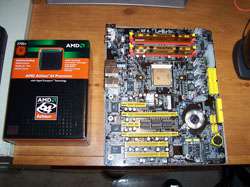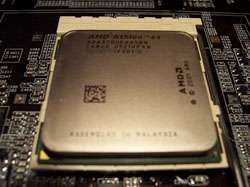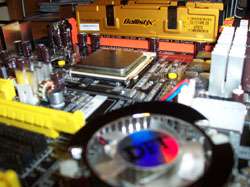- Qualcomm Launches Snapdragon 4 Gen 2 Mobile Platform
- AMD Launches Ryzen PRO 7000 Series Mobile & Desktop Platform
- Intel Launches Sleek Single-Slot Arc Pro A60 Workstation Graphics Card
- NVIDIA Announces Latest Ada Lovelace Additions: GeForce RTX 4060 Ti & RTX 4060
- Maxon Redshift With AMD Radeon GPU Rendering Support Now Available
AMD64 3700+ San Diego S939 2.2GHz

Need a CPU and want the best bang for your buck? Today, we are taking a look at the 3700+ San Diego core AMD64. It rolls in at a 2.2GHz stock speed and is also equipped with 1MB L2 Cache. The chip costs around $275US, but does does it give enough extra performance to warrent the extra money over a Venice core?
Page 1 – Introduction
Here at the Techgage labs, on the border of sanity, we have a brand new Athlon 3700+ San Diego in for review. If you have found your way to our little corner of the ‘net, I am certain that AMD needs no introduction. But, for all of you techies out there that have been living under a rock or in Siberia, AMD is the premiere gaming CPU of choice for anyone “in the know”.
This is a debatable statement at best so through out the review, we will see what this chip has to offer. I have owned a 3500+ Winchester core before this. so I am excited to see what the difference an extra 512 of L2 will help out. It’s been a while since we have taken a look at a CPU so let’s get into the meat of this review.
About Advanced Micro Devices
Founded in 1969 and based in Sunnyvale, California, AMD provides microprocessors, Flash memory devices, and silicon-based solutions for our customers in the communications and computer industries worldwide.
However, our focus goes beyond integrated circuits and transistors. AMD is committed to helping our customers — and their customers — take advantage of the phenomenal capacity of silicon to add value and help differentiate their offerings. To that end, AMD products are developed with customer needs always in mind and not for the sake of innovation alone. Stated more plainly, it means that AMD exists to provide real solutions for real customer problems that exist in the real world today.
Earlier this year, AMD released their Venice and San Diego core processors. The primary differences between the two, is that the Venice uses 512Kb L2 Cache, and the San Diego uses 1024Kb L2 Cache. Venice is for the casual mainstream computer user, while San Diego could be the hardcore gamers core of choice.
Both Cores, use a 90nanometer process, as all the current AMD chips being produced will. AMD recently got rid of the 130nm cores, and because of this, the potential of the chip is better.. lower temperatures and higher overclocks. Even the Winchester core at 90nm, couldn’t handle higher frequencies, which held some overclockers back, and this is where Venice could make it’s mark.
So what does the Venice bring to the table, to make it better than the Winnie? AMD added the SSE3 Instruction set to both the Venice and San Diego, which should help out in some areas, primarily media and development, but not gaming. It should be mentioned that this is not a simple copy/paste, so to speak, of the SSE3 instructions from the Prescott Intel chips. Prescott has a few more instructions in the set, that are used towards their Hyper-Threading technology. So if you were considering an Intel due to the Hyper-Threading factor, then the addition of SSE3 to the Venice/Sandy shouldn’t sway you.
Another feature added, is a better memory controller. Previously, with 4 Double Sides sticks, you were forced with 2T at 166MHz. That’s been fixed so now you can get 200MHz at both 1T for Single Sided and 2T timings for double sided.
Specifications
- AMD Athlon 64
- 3700+ (San Diego core)
- 2.2 GHz operating frequency
- 1MB L2 cache
- Socket 939
- E4 stepping
- 90nm SOI
Pics! Pics! Give me pics!
This 3700+ is by no means an immediate relative to its namesake cousin of the s754 flavor. This is a beefy CPU to say the least with the same identical core as the FX line of chips, I have lofty goals for the results of this chip. Over the course of this review, I will include results from a variety of benchmarks as well as frame rates in a few of the most popular and demanding games out at the time of release.
Support our efforts! With ad revenue at an all-time low for written websites, we're relying more than ever on reader support to help us continue putting so much effort into this type of content. You can support us by becoming a Patron, or by using our Amazon shopping affiliate links listed through our articles. Thanks for your support!







